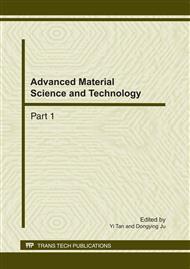p.495
p.499
p.503
p.507
p.511
p.515
p.521
p.525
p.529
Experimental Study on Strength and Deformation of Brittle Rock under Different Compression Condition
Abstract:
This paper studies on the characteristics of strength and deformation of brittle rock under different compression condition by experimental tests. A lot of experimental tests for the Xiangjiaba sandstone are carried out under different compression condition, including uniaxial compression, triaxial compression, uniaxial monocyclic compression and uniaxial loading and unloading. Base on the experimental test results of the Xiangjiaba sandstone, the strength and deformation of brittle rock are analyzed, and some comparative analysis for the mechanics characteristics of brittle rock are carried out. The compute results show that, the peak strength of brittle rock is increased with the confining stress, and close to a linear relationship. Its also show that, the peak strength is not increased under the monocyclic compression, neither for the loading and unloading condition.
Info:
Periodical:
Pages:
511-514
Citation:
Online since:
February 2011
Authors:
Price:
Сopyright:
© 2011 Trans Tech Publications Ltd. All Rights Reserved
Share:
Citation:


